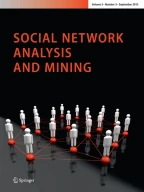Abstract
Cooffending networks, whose nodes are criminals and whose edges reflect when sets of criminals were involved in the same crime, have been well-studied. They inform the motivations for cooffending, for example, when criminal collaborators have particular skills; and the way in which criminality and risk spread. However, little is known about how cooffender networks intersect with the ordinary social networks that connect criminals to those around them: families, neighbors, and acquaintances. Such networks are important for law enforcement because these individuals are at risk because their associations with criminals, and because they may, perhaps unwittingly, play a role in criminal activities. Such networks are difficult to leverage because the data the require is hard to collect. Work by, among others, Papachristos has shown that the risk of gun violence is better understood from social-network position than from more conventional properties such as race, demographics, or socioeconomics. Given this, using social-network analysis provides a path away from broad-brush profiling based on such properties to a finer-grained assessment of risk based on properties that are demonstrably relevant. The innovation in this article is to define an alternative to laborious hand-gathered data about the social networks in which criminals are embedded: copresence networks whose nodes are those present at incidents attended by police, and whose edges count the number of times each pair of individuals are at the same incident. Within such networks, nodes can be divided between those who are charged (criminals), and those who are not (victims or witnesses). At first glance, victims and witnesses might seem to be a random subset of ordinary citizens whose presence at an incident with a perpetrator is happenstance. However, spectral embedding of copresence networks shows that the presence of victims and witnesses at incidents is not random; their rates of involvement are highly skewed. This suggests that they do not become involved in incidents by being at the wrong place at the wrong time, but because they are already at such a place and time. In other words, victims and witnesses are often already in the milieu of criminals. Thus, copresence networks approximate the intersection of criminal social networks with the wider networks in which criminals live, and they can be constructed from ordinary record management system data rather than in more intrusive ways. The contributions of this paper to applied policing are: (a) we show that cooffending networks are not freestanding and separate from the wider social connections of civilians, but rather are intertwined with them in complex ways; and (b) we show that the skew in activity already known for cooffending networks also applies for copresence networks. Hot spot policing techniques used for crime should leverage the extra connection information from copresence networks to, for example, understand connections between apparently unconnected criminal groups, and develop models for victim choice.
Similar content being viewed by others
Data availability
Data are confidential.
References
Bichler G, Malm A, Cooper T (2017) Drug supply networks: a systematic review of the organizational structure of illicit drug trade. Crime Science 6(2)
Calderoni F (2014) Identifying mafia bosses from meeting attendance. In: Masys A (ed) Networks and Network Analysis for Defence and Security. Springer, Berlin, pp 27–48
Charette Y, Papachristos AV (2017) The network dynamics of co-offending careers. Soc Netw 51:3–13
Chung FRK (1997) Spectral graph theory. Number 92 in CBMS Regional Conference Series in Mathematics. American Mathematical Society, ??? (1997)
Gläser U, Tayebi M, Brantingham PL, Brantingham PJ (2012) Estimating possible criminal organizations from co-offending data. Technical Report 29, Public Safety Canada (2012)
Green B, Horel T, Papachristos AV (2017) Modeling contagion through social networks to explain and predict gunshot violence in Chicago, 2006–2014. JAMA Intern Med 177(3):326–333
Lantz B, Hutchison R (2015) Co-offender ties and the criminal career: The relationship between co-offender group structure and the individual offender. J Res Crime Delinq 52(5):658–690
Leuprecht C, Hall K (2014) Why terror networks are dissimilar: how structure relates to function. In: Networks and Network Analysis for Defence and Security, pp 83–120
Luxburg U (2007) A tutorial on spectral clustering. Stat Comput 17(4):395–416
Nick B, Lee C, Cunningham P, Brandes U (2013) Simmelian backbones: Amplifying hidden homophily in Facebook networks. In: Proceedings of Advances in Social Network Analysis and Modelling ASONAM, ACM & IEEE
Papachristos AV, Braga AA, Piza E, Grossman LS (2015) The company you keep? the spillover effects of gang membership on individual gunshot victimization in a co-offending network. Criminology 53(4):624–649
Papachristos AV, Wildeman C, Roberto E (2015) Tragic, but not random: The social contagion of nonfatal gunshot injuries. Soc Sci Med 125:139–150
Papachristos AV, Braga AA, Hureau DM (2012) Social networks and the risk of gunshot injury. Journal of Urban Health 89(6)
Skillicorn DB, Calderoni F (2015) Inductive discovery of criminal group structure using spectral embedding. Inform Secur 31:49–66
Skillicorn DB, Spezzano F, Subrahmanian VS, Garber M (2014) Understanding South Asian violent extremist group-group interactions. In: FOSINT 2014 at ASONAM 2014
Acknowledgements
N/A.
Funding
David Skillicorn is supported by the Natural Science and Engineering Research Council of Canada. Christian Leuprecht is supported by the Social Science and Humanities Research Council of Canada.
Author information
Authors and Affiliations
Contributions
Equal.
Corresponding author
Ethics declarations
Conflict of interest
The authors declare that they have no competing interests.
Additional information
Publisher's Note
Springer Nature remains neutral with regard to jurisdictional claims in published maps and institutional affiliations.
Rights and permissions
About this article
Cite this article
Skillicorn, D.B., Leuprecht, C. Copresence networks: criminals in their environment. Soc. Netw. Anal. Min. 11, 85 (2021). https://doi.org/10.1007/s13278-021-00796-2
Received:
Revised:
Accepted:
Published:
DOI: https://doi.org/10.1007/s13278-021-00796-2
